A version written with simpler HTML than this first version can be found here. It was re-written by Tony Boys, because some site visitors from South America could not read this original article. A copy can also be found here at http://www9.ocn.ne.jp/~aslan/nonukes/notonukes01.html . - Ed.

At 2:20 pm I got fed up with the translation I was working on so I saved it and then backed it up on a USB flash drive. Then I browsed through some daily newsletters I receive on the Internet, saving a few of the articles I thought were useful. The last time stamp was 2:38. I was about to shut down the PC when I noticed that my mp3 player was still recharging, so decided to leave it on and do something else. That was when I felt the first tremors…"All the reactors are screwed and we are looking at the very worst situation right now. Even on the BBC those mysterious water puddles the TEPCO guys paddled in have 10,000 times the radiation levels. 10,000. That means the core reactor is leaking. The zirconium cladding tubes of the spent fuel rods are also cracked like broken egg shells. Reactor 3 with the MOX uranium and plutonium is responsible for the now much higher radiation levels (8 times last week - which was bad enough in itself).Vast tracts of northern Japan, including Tokyo and as far south as Osaka are going to be uninhabitable. Hokkaido may be ok, but too cold to support life without adequate cheap fuel."
Note: Story was copied to here /node/2411 from /node/2407 in an attempt to overcome a formatting problem which caused the left and right columns to disappear or be pushed down the page. Although it first seemed to solve the problem, the problem now seems to have returned. - Ed, 29 Mar 11.
See also Filmed interview with Tony Boys 27 March 2011
The room shook violently! It seemed to be vibrating violently at about five shakes a second and then at the same time shunting back and forth in an east-west direction about once a second. Books and CDs began to fall off shelves. It seemed to be going on for a very long time and gaining in intensity as it did. I was hanging on to my PC! I went into the adjoining room to see where my wife (Chisato) was. She was hanging onto the Buddhist altar and the TV! She was OK, so I went back to my room and made sure the PC didn’t fall off the desk. The electricity had already gone. The room was still shaking very violently. I began to wonder if the house was going to collapse. I was very, very frightened. After a few more minutes the shaking became less violent and eventually stopped. Five or six minutes in all, I think.
Where I live is Hitachi Omiya City, northern Ibaraki, about 120 km north of Tokyo on the Pacific coast and about 20 km inland from Hitachi City. Quite a long way south from the epicentre of the M9.0 earthquake that struck northeast Japan at 2:46 pm on March 11, 2011.
We were lucky. None of our bookshelves fell over (they are either built-in or secured by plates which are screwed up tightly to the ceiling). A few glasses and pieces of crockery broke. The bread-baking machine fell off its perch and was obviously broken beyond repair. Big deal. No electricity, no water.
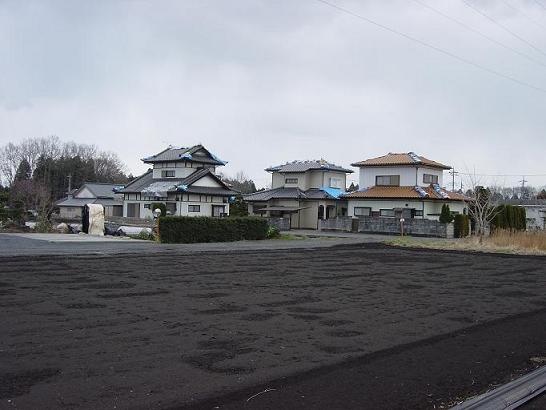
[1. Damaged roofs of houses nearby. Mostly the curved tiles of the ridges have shaken loose.]
Taking a look outside it was immediately obvious that the roofs of houses with nice Japanese roof tiles had been damaged. Thick stone walls had also collapsed. We later found out that further north whole cities, towns and villages had been ‘wiped out.’ You’ve probably seen the pictures. Very, very sad, but I do not want to go into that here.#1 [If you comment, ask questions, ask for more detail, or if you want to add more information as a comment, can you please quote the number at the end of the paragraph, if appropriate.]
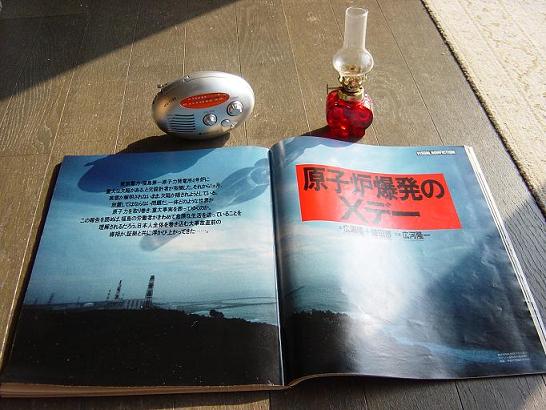
[2. The wind up radio, the tiny lamp and the Days Japan magazine with the now familiar sight of Fukushima No.1 Power Station. See below.]
Chisato eventually managed to find a tiny alcohol lamp, some candles, and a ‘wind up’ radio that doubled as a cell phone recharger. Fantastic. Our most important equipment for the two days before electricity was restored. For water, we were able to get fairly clean water for washing from the well at Chisato’s mother’s house, less than one km away. The water is usually pumped to a tap by an electrical pump, but that was not working, so she had taken off the lid and set up a rope and bucket. 15 and 20 litre water containers that Chisato had stored away for just such an eventuality were brought out and so we were able to get water back to the house using my ‘light truck.’
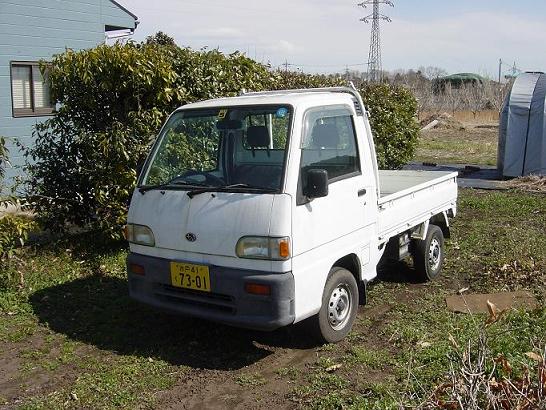
[3. Light truck.]
For potable water, we used the local (about 1.5 km away) spring. Lots of other people, of course, had had the same idea, so it was necessary to queue. Since this is a rural area, there is food around. No problem. It is early spring here; cold, but not unbearably so. Nice when the sun shines. Gasoline looked like it was going to be a problem, but our three cars (my light truck and my son and daughter’s two small cars) had been filled up during the previous week, so, again, lucky.#2
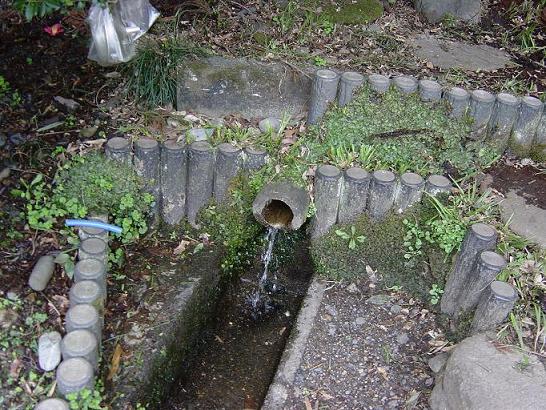
[4. Closeup of the spring. Note the funnel and other utensils hanging on the branch. These were brought by a neighbour for everyone's use. They're still there.]
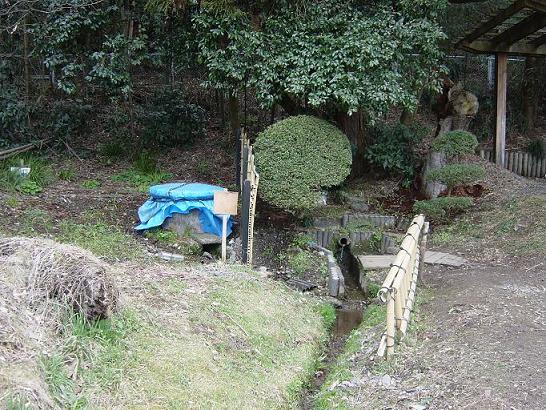
[5. The spring. Once water supplies were resumed, about a week after the earthquake, things went back to normal here. The blue sheet and chain over the concrete structure on the left are a permanent feature.]
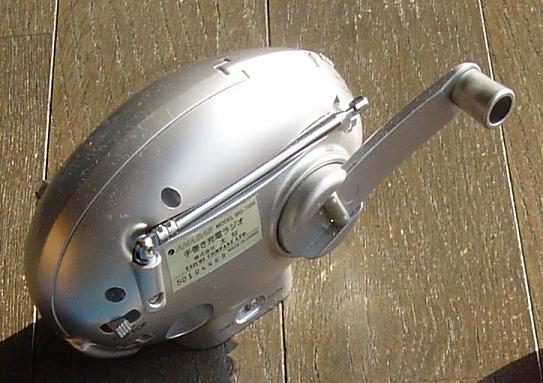
[6. The back of the wind up radio showing the dynamo handle extended. Essentially the same principle as a nuclear power station, but using a different power source and therefore not nearly so dangerous.]
The Disaster at Fukushima No.1 Power Station
Lamp-lit dinners with the wind-up radio. That’s when we heard about Fukushima No.1 Power Station. At first it seemed that one or perhaps two reactors had been affected. Later, as you know, four (1-4) of the six reactors at that site experienced serious problems, and as I write these have not been stabilised. The other two (5 and 6) experienced some problems, but were stabilised later, when they were connected to an external power line.#3
Until March 11, Japan had 54 commercial nuclear reactors operating, 15 of which are situated along the Pacific coast between Ibaraki and Aomori Prefectures. Fukushima No.1 and No.2 Power Stations, about ten km from each other, had a total of ten reactors. None of the nine reactors in power stations other than Fukushima No.1 experienced serious problems in shutting down after the earthquake. The Tokai reactor, only about 20 km from here, had to start up its backup diesel-powered cooling pumps in order to cool the reactor. It is not clear if the control rods were properly inserted into the reactor core to shut the reactor down when the earthquake struck.#4
Please see these pages for descriptions of emergency shutdown measures at nuclear power stations.
Scram - emergency insertion of control rods into the reactor core
ECCS - Emergency Core Cooling System
My first reaction was one of horror. Several Chernobyls simultaneously? Thankfully, it does not seem to be that serious, more like a quadruple Three Mile Island (one of them being a plutonium-burning ‘pluthermal’ reactor), and that is quite serious enough. Since the story is not over yet, it may still get even more serious. Two days after the earthquake, just before the electricity service was resumed, I bumped into one of Chisato’s relatives as I was taking our dog for a walk. Since there is a nuclear power station near here, people naturally have friends who have worked in the stations up and down the coast, and know about the realities of the reactors and so on. He’s obviously in the loop. He had quite a serious story to tell about the problems at Fukushima No.1. These are unconfirmed statements, so you, like me, should take them with a large pinch of salt. 1) When the earthquake struck, the control rods did not enter the reactors properly. 2) The diesel fuel had been taken out of the diesel generator that runs the emergency backup cooling pumps. 3) The power station is being run by subcontractors of subcontractors.#5
Let’s look at these in turn. 1) When a (serious) earthquake tremor is perceived, the control rods are supposed to be inserted into the reactor core. From the links above, this happens in about four seconds. It’s still not clear to me what actually happened at Fukushima No.1 reactors 1-3 (4 was down for maintenance so there were no fuel rods in the core). It seems that the control rods did not insert correctly, but it is not certain whether that was because of the strength of the earthquake or because of mismanagement, poor maintenance and so on. 2) In any case, if the control rods failed to enter the reactor core(s), the emergency core cooling system (ECCS) should have then kicked in to cool the reactors. It has now been revealed in the media (e.g. on NHK TV news programmes) that “the diesel generator started but very soon stopped for lack of fuel.” Personally, I prefer to think that fuel in the tank(s) had been used when checking if the generator(s) and pump(s) were in working order or not, and then no one thought to top up the tank again (over several years?) rather than to believe that the fuel had actually been removed for some reason, but we will have to wait and see if the committee that eventually investigates the accident will come up with an answer. 3) We have always been told that nuclear power is safe, and some of the reasons often cited are ‘superior Japanese technology’ and ‘superior Japanese management capabilities.’ When someone tells me that a power station is ‘being run’ by subcontractors of subcontractors, I am a bit sceptical about what that actually means. Does this refer to people in the control room? I hope not. Does it refer to the people who are doing maintenance and repair? Almost certainly, but under whose supervision is this carried out? Perhaps we will have some answers from the committee of investigation.#6
Looking at the daily newsletters I read – Energy Daily and Terra Daily - this article about the Tokyo Electric Power Company (TEPCO) was included in the March 21 issue: Days before quake, plant operator admitted oversight. I’ll just quote one small part: …inspections, which are voluntary, did not cover other devices related to cooling systems including water pump motors and diesel generators. It’s obvious from the article that TEPCO’s mismanagement of nuclear power stations has been going on for a long time. Many Japanese are well aware of this. Other examples can be found on the pages of the website of the Citizen’s Nuclear Information Center in Tokyo, which has an English nuclear safety page where you can find such articles as "Not Again": Yet Another TEPCO Scandal. Ten Japanese power companies, covering all regions of Japan except Okinawa, have commercial nuclear power stations. TEPCO seems to have more ‘problems’ than others, though it is well known that some of the other power companies also have quite serious ‘problems.’ This article is also worth a look: The moment nuclear plant chief WEPT as Japanese finally admit that radiation leak is serious enough to kill people.#7
On the next day (March 22), this article was carried by the Terra Daily: Japan nuke plant ‘was crippled by 14-metre tsunami’. I want to quote this article a little, because it seems to have a direct bearing on the facts of the accident.
The monster tsunami which left a Japanese nuclear power plant on the brink of meltdown measured at least 14 metres (46 feet) high, the plant's operator said Tuesday
.
The Tokyo Electric Power Co. (TEPCO) had earlier estimated the height of the wave at 10 metres at its Fukushima No. 1 plant, some 250 kilometres (155 miles) northeast of Tokyo.
A massive 9.0-magnitude quake on March 11 triggered colossal waves along the country's Pacific coast, crippling the plant's cooling systems and prompting emergency operations to prevent fuel rods from melting and spewing radioactive material.
“Now we estimate the height at more than 14 metres. We have found traces of the tsunami at such elevations," TEPCO spokesman Naoki Tsunoda said, adding that the wave was 14 metres high when it passed through the plant's parking area.
A tsunami can surge to an elevation higher than its height at the time when it hits shore, Japanese media noted.
First TEPCO is saying that the tsunami was estimated at 10m. Then they say “traces” of the tsunami were found at elevations (above sea level?) of 14m. The article appears to suggest that the tsunami was responsible for crippling the plant’s cooling systems, but makes no mention of the lack of fuel in the diesel generator. A local (Mito Broadcasting Station) NHK news programme I saw mentioned that at Kitaibaraki City the height of the tsunami was 6.3 m above sea level. This was very nicely shown with reference to a level ‘tide mark’ on the side of a building at the top of the beach, probably somewhere around 36 deg. 47’ 45.00” N, 140 deg. 45’ 28.00” E, if you like to look at Google Earth. About 110 km further south in Ibaraki Prefecture the tsunami was reckoned to be 4.8 to 4.9 m (around Kashima). Fukushima No.1 Power Station is about 75 km north of Kitaibaraki City. You can see the power station at 37 deg. 25’ 18.30” N, 141 deg. 02’ 00.30” E. The coastline is quite smooth here, not like the ria coast further north, where the tsunami caused really horrific damage. Perhaps when the investigative committee does its work we’ll find out what “traces” of tsunami are.#8
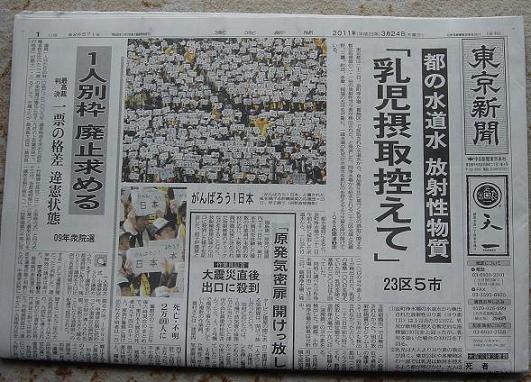
[7. Tokyo Newspaper, 24 March 2011, Front page. Headline on right says, "Radioactive material in capital's water system. Ingestion restraint for infants." Pictures and caption to left: High school students at the high school baseball tournament in Osaka holding up placards saying "Gambaro! Nippon" - Pull out all the stops! Japan. Lower centre article: Headlines - "Nuclear power station airlock doors left wide open. Rush for the exits following the earthquake" - This article is the lead for the one below on p.2 of the newspaper.]
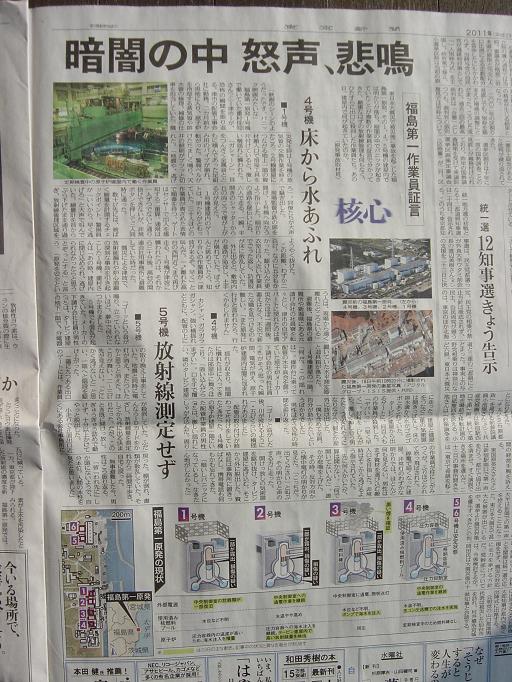
[8. Long eyewitness article on p.2. The headline says, "Shouts and screams in the dark". Below, the daily update on the situation at the four troubled reactors at Fukushima No.1 Power Station.]
I was also wondering how much time passed between the earthquake and the arrival of the tsunami. I found a pretty good answer for that in the 24 March edition of the Tokyo Newspaper. A long article gives eyewitness accounts of the scenes inside reactors 1, 4 and 5 just after the earthquake occurred. A repair worker in reactor 1 managed to escape from the reactor building in about five minutes. (Except for small emergency lights it was completely dark inside the building and many people were rushing for the exits at the same time.) Once outside, a friend called to him, “Quick, there’ll be a tsunami coming!” They ran about one km to higher ground near the west gate. The tsunami came about 30 minutes after that, so we can reckon 40 to 45 minutes between the earthquake occurring and the tsunami arriving. Since the external electricity supply had also stopped (no lighting inside the buildings) that meant 40 minutes when the diesel generator should have been running.#9
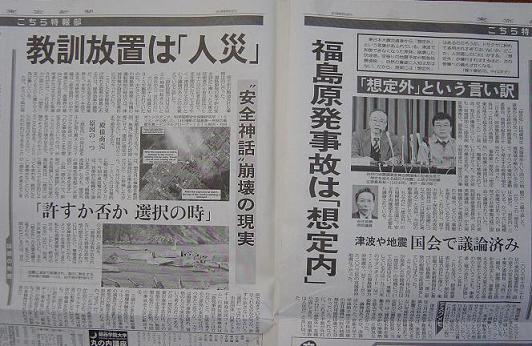
[9. Long article on pp.18 and 19. Headlines on right (p.18) - "Accident at Fukushima power station was 'within foreseen circumstances", "The excuse of 'beyond foreseen circumstances'", "Tsunamis and earthquakes already discussed in parliament". Headlines on left (p.19) - "Lessons not learned = 'man-made' disaster", The reality of the collapse of the 'safety myth'", "Time to choose whether to allow (nuclear power) or not".]
Another long article on pages 18 and 19 of the same issue of the Tokyo Newspaper, shows how, despite TEPCO’s claim that the earthquake and tsunami had been “beyond foreseen circumstances,” possible earthquake and tsunami scenarios and power station preparedness had been discussed in parliamentary committees, and the Director of the Nuclear and Industrial Safety Agency had stated in an answer to a question about large tsunamis damaging the cooling system that, “Supplementary water systems would be brought into operation to remove decay heat from the nuclear reactor.” The newspaper concludes that the disaster was therefore not a natural one, but a man-made disaster.#10
While clearing up some of the books and magazines that had fallen off the shelves during the earthquake Chisato found a September 1988 issue of a Japanese magazine called Days Japan. The cover has a large picture of Mr Gorbachev and his wife waving as they board a plane and in large letters at the foot of the page “Nuclear Reactor Explosion X Day.” (See photo 2) The article, including title and ending runs for 16 pages and is mostly about Fukushima No.1 Power Plant, and especially the design problems of reactor 4. Twenty-two years and 6 months later…#11
What’s happening now?
As I write this on March 26, NHK news is telling everyone that today is the 40th anniversary of the date in 1971 of the startup of reactor 1 at Fukushima No.1 Power Station. Not much to celebrate. The four reactors are still not under control. Some of the most informative and revealing articles I have read about the unfolding disaster are on a site suggested to me by a British friend now living in Kyushu, in the south of Japan; The Automatic Earth. If you scroll down the page, you will see Troubled Plant Had High Rate of Problems, Records Show, by Andrew Morse - Wall Street Journal and Japan Raises Possibility of Breach in Reactor Vessel, by Hiroko Tabuchi, Keith Bradsher And David Jolly - New York Times. Concerning reactor 3, the pluthermal one, this latter article had the following to say.
A senior nuclear executive who insisted on anonymity but has broad contacts in Japan said that there was a long vertical crack running down the side of the reactor vessel itself. The crack runs down below the water level in the reactor and has been leaking fluids and gases, he said.
The severity of the radiation burns to the injured workers are consistent with contamination by water that had been in contact with damaged fuel rods, the executive said.
"There is a definite, definite crack in the vessel — it’s up and down and it’s large," he said. "The problem with cracks is they do not get smaller." (Bold and italic as in original)
Totally horrifying. The article makes it clear that it will be at least two more weeks before the reactor is fully under control, and that decommissioning will be a big, big headache for TEPCO and the Japanese government. The radiation problem will be with us for months to come, probably years. IF they get the reactors under control.#12
Nuclear power is an extremely dangerous technology. So dangerous that we really shouldn’t be doing it. A well-known organic farmer who lives in Ibaraki Prefecture, Mr Jiro Kakei, has said, “Technologies progress through failure, but nuclear power is a technology that does not allow for failure.” That pretty well sums it up. People who do not live near nuclear power stations and do not hear of the problems they have may feel that nuclear power is OK as long as there are no serious accidents. However, the routine day-to-day running of nuclear power stations involves significant human suffering. The repair worker mentioned a few paragraphs above was a young man employed by a plumbing company in Tsu City, Mie Prefecture, about halfway between Nagoya and Nara. After returning to his flat in Tsu a week after the earthquake, with no savings and little hope of finding a job in Japan’s current recession, he said, “If I’m told to go to another nuclear power station, I might go.” He also said, “Those who say nuclear power stations are safe are in places a long way from the actual sites.” Maintenance and repair work in nuclear power stations involves people putting their lives on the line. They are frequently day-wage labourers who have few alternative opportunities to make money. In other words, they are only doing the work because they are desperate. Besides the fact that these relatively unskilled people are doing work society expects to be done perfectly, how can we condone the fact that anyone at all is having to do this work? It probably cannot be done in any way that does not adversely affect the worker’s human rights. We’ve known this for a long time, at least since the 1970s, but it does not prevent power companies from building and operating nuclear power stations. #13
The Future
What’s the worst case scenario for Japan? As I began to write this today, my friend in Kyushu sent me this message:
All the reactors are screwed and we are looking at the very worst situation right now. Even on the BBC those mysterious water puddles the TEPCO guys paddled in have 10,000 times the radiation levels. 10,000. That means the core reactor is leaking. The zirconium cladding tubes of the spent fuel rods are also cracked like broken egg shells. Reactor 3 with the MOX uranium and plutonium is responsible for the now much higher radiation levels (8 times last week - which was bad enough in itself).
Vast tracts of northern Japan, including Tokyo and as far south as Osaka are going to be uninhabitable. Hokkaido may be ok, but too cold to support life without adequate cheap fuel.
This is also how we get the die off. Japan will become half a country and Fukuoka the emergency capital. Population decimated by cancer. The Fukushima complex will have to be sarcophagized - it should already have been done by now.
Japan unable to feed herself presently as it is, is heading for a real shocker. It’s not hard to imagine. Best rice, water and sake are from the north. All that will be gone like the spinach and milk - all down the drain and into the sea killing the fish and other creatures.
We have been lied to every step of the way by TEPCO and the government. Why? In order to save the stock market and a possible world financial crash. They also didn't want to cause (necessary IMO) mass panic.
Mephistopholes is a-calling. The bargain is up and Faust is as good as dead. Our time in the sun was rapid and brief - how typically Japanese - like the ephemeral sakura.
I don’t think it's this bad yet, but it could happen. If it does, this is the last you will hear from me.
It is now abundantly clear to many, many people around the world that ‘we’ (humankind) are approaching planetary limits. The factors inherent in the very systematic and complex problem of population, food and energy – farmland area, rising population, economic development causing larger numbers of people to eat more animal protein, falling availability of or higher prices for energy that is converted into fertilizers, pesticides and other agricultural materials or used as fuel for agricultural machinery (or used to produce agricultural machinery) – is steadily, and not too slowly, moving towards an unavoidable chicane. At some point in time we have to say ‘no’ to the current system of placing economic growth and economic development above all priorities, and to placing money values and considerations above all others. The alternative to saying ‘no, let’s change the way we do things’ is general systemic crash or collapse. I don’t mean in a few decades in the future – the crash is already here, it just doesn’t make itself apparent everywhere in the world at the same time. (We still haven’t recovered from one of the warning signals, the financial crisis of 2007-2008.) #14
I believe that now is one of those points in time when we have an opportunity to say ‘no’ to the current system, the current mind-set, and start to move toward wherever we need to go, want to go, during the rest of this century. And I think the first step on this path is to say ‘no’ to nuclear power. Now. Yesterday I also read tim’s article Questions That Continue To Bedevil Me. I was surprised because he said basically the same thing. tim wrote:
I came to the realization that saving the environment was not a juggling act between causes and factors that demand equal attention, but more like a golf game. In golf, you don't begin by trying to figure out how best to sink the ball in 18 holes, by dispersing your attention to all of them simultaneously. You focus on the first hole. Without sinking the ball in the first hole, all other holes are irrelevant. In terms of environmental degradation, achieving a sustainable population level is that first hole.
Sorry, tim, I think we need to stop nuclear power first. Or perhaps stopping nuclear power is the first ‘stroke’ in the game rather than the first ‘hole.’#15
For about 20 years I have been researching population, food and resource problems, and since 1998 specifically Japan’s food and energy problem. (See Food and Energy in Japan -- How will Japan feed itself in the 21st century? [please scroll down to see the link]) For a long time I have been saying that the coming energy crisis (See: Sheila Newman, ed., The Final Energy Crisis, 2nd Edition, Pluto Press, 2008) will mean serious food shortages for Japan. Some people agree, some don’t. Whatever the energy equation may be, and however the associated food crisis may or may not occur, because of the problems of nuclear power described above I decided yesterday (March 25) to try to organize a ‘campaign,’ the aim of which is:
To see that no new nuclear power stations (or reactors) are built in Japan (or any other country) and that all reactors now running are phased out when their lifetime (stated at the time of construction) is up – or by some relatively close date, say 2020. In the meantime, nuclear power stations should be run as safely and as humanely as possible.
Here’s the small print: In principle, all other nuclear facilities and research centers [for medical applications, fast-breeders, reprocessing plants, nuclear fission research and so on] should also be phased out under the same time schedule as the commercial nuclear reactors. However, it may be felt that some of this should be maintained. That will be something for people at the time to decide.
I hope to try to get as many people as possible, all over the world as well as in Japan, to join in this campaign, or to join with others who have already organized a similar campaign and who basically share the same aim.
What will happen when we try to stop nuclear power? Some people are going to scream, No, no, you can’t do that, because when oil runs out we won’t be able to maintain our economy. There are at least two problems with this. Briefly, nuclear power requires oil (or other fossil fuels) to for many of its operations. Think of mining and refining uranium ores, enrichment, fabrication of fuel rods, construction of reactors, all the transportation that involves, decommissioning of reactors and storage or disposal of nuclear waste, and so on without oil. Difficult, to say the least. Secondly, in the same way that ‘we’ passed over the conventional oil peak (world peak volume extraction of conventional crude oil, often known as peak oil) in 2006 (finally admitted by the IEA last November) the peak of uranium extraction is now thought to be sometime before 2030 for reasonably assured resources or in the early 2040s for reasonably assured resources + inferred resources below US$130/KgU, at current rate of consumption. Roughly 30 years later than peak oil. (Uranium Resources and Nuclear Energy, Energy Watch Group, December 2006, see graph on p.5, ) In other words, nuclear power will never provide the energy that fossil fuels have up to now, and the more we try to do that the more dangerous it will be and the sooner the resource will ‘run out.’ #16
So, if we think of saying ‘no’ to nuclear power, we have to think about the future of energy. That will mean that we will have to think about the future of the economy, jobs, money, how we get our food, and just about everything else, and that leads on to what kind of society we want to live in – what kind of society we want to create for the future, the future we hope our grandchildren and great grandchildren will enjoy in the 22nd century. As I said above, we are going to have to think about these things sometime soon anyway; think about how to step back from the brink. The alternative to not making that choice now, or soon, is some form of general social collapse almost everywhere, but especially in the advanced industrial countries, where people have been lulled into thinking (by the present system) that the current arrangements of economic growth can go on forever.#17
What I would like to ask you, please, to do
Let’s assume the current crisis at Fukushima No.1 Power Station is going to be ‘solved’ – well, reasonably well. Let’s not go back to sleep. What can I ask you to do? (1) Can you please comment below if you have something you have to say to me and to everyone else who may drop in candobetter.net to read this page, or if you have a question you want to ask me. (2) Or please just leave a short message of support as a comment if you agree with what I have said and the 'campaign' above. (3) Please support the Citizen's Nuclear Information Center (www.cnic.jp) by going to their English support page, or send a message of support to any to any other organization you may know that is campaigning against nuclear power. (4) If you think it’s worth the time of day, please ask your friends to read this, comment, and make some small gesture of support too. (5) Please link this article from other blogsites, Facebook, Twitter and/or any other SNS sites you use. (6) Please also ask every Japanese person you know to read it. If they want to write to me in Japanese, please encourage them to do so. (7) Please suggest to Avaaz.org, Care2 petitionsite and other campaigning and petition sites and organizations that they list this ‘campign’ on their websites. (8) Please let me know what else I can do to reach more people. (9) But let’s all, together, take the first step away from insanity and towards taking back our lives by saying ‘no’ to nuclear power, all over the world, not just in Japan. Say "No to nukes!" #18


Comments
Martin J Frid (not verified)
Sun, 2011-03-27 14:01
Permalink
Organic Farmers: Appeal to Decomission All Nuclear Reactors
Brad Larrick (not verified)
Sun, 2011-03-27 14:39
Permalink
Why haven't they sarcophagized the reactors?
Tony Boys
Sun, 2011-03-27 18:24
Permalink
Thanks for your comment, Brad.
Anonymous (not verified)
Sun, 2011-03-27 19:10
Permalink
Real facts about nuclear power
Subject was: Real Facts
Ed. The author of the following comment has supplied a very out-of-date resource. The simple explanation he or she refers us to was last updated on 14 March, with a comment that radiation levels were increasing but it was not known to what level. Here is the unhelpful comment I am criticising:
Stop scaremongering and read some real facts.
http://bravenewclimate.com/2011/03/13/fukushima-simple-explanation/
The out-of-date article, referred to above is: Fukushima Nuclear Accident – a simple and accurate explanation posted on 13 Mar 11. The opening paragraph of that article is:
Along with reliable sources such as the IAEA and WNN updates, there is an incredible amount of misinformation and hyperbole flying around the internet and media right now about the Fukushima nuclear reactor situation. In the BNC post Discussion Thread – Japanese nuclear reactors and the 11 March 2011 earthquake (and in the many comments that attend the top post), a lot of technical detail is provided, as well as regular updates. But what about a layman’s summary? How do most people get a grasp on what is happening, why, and what the consequences will be?
- Ed
David holmes (not verified)
Sun, 2011-03-27 18:29
Permalink
words are not enough
David Harringto... (not verified)
Sun, 2011-03-27 19:15
Permalink
Tony, you have succinctly
Yoko (not verified)
Sun, 2011-03-27 22:32
Permalink
The accident had to happen...and to create the alternative..
Tony Boys
Mon, 2011-03-28 11:37
Permalink
The accident had to happen...
Dave Kimble (not verified)
Mon, 2011-03-28 13:40
Permalink
nuclear technology
Tony Boys
Mon, 2011-03-28 19:27
Permalink
nuclear technology
Kato (not verified)
Mon, 2011-03-28 02:09
Permalink
from Mito
Nick (not verified)
Mon, 2011-03-28 08:23
Permalink
Radiation dose chart to put Fukoshima in perspective
Maybe what Tony says is true, but the following link puts Fukoshima in perspective.
Radiation Dose Chart at http://xkcd.com/radiation/
Editor's comment: As an example, the chart shows that the radiation dose from a medical procedure, for example a Chest CT scan, is 5.8 milliSieverts (mSv), whilst in 2010, a radiation dose from standing on the grounds of the Chernobyl nuclear reactor, which melted down in 1986 could be 6 mSv (although I couldn't find any figures showing actual or estimated exposures during the meltdown itself). Many of the sample doses are smaller than that. The maximum external dose from the Three Mile Island partial core meltdown is shown as 1 mSv. The exposure from natural Potassium in the body over one year is shown as 390 microSieverts (or 0.39 mSv). The exposure from a Chest X-ray is 20 microSieverts (or 0.02 mSv). One could interpret from this chart that the potential radiation exposure from nuclear accidents is comparable to some radiation exposures that many people already find acceptable. However, Tony and other residents of Japan are in fear for their very lives from the nuclear disaster. If the worst does not happen, a large number of Japanese are almost certain to suffer adverse health effects as a consequence of their exposure. I would like to know if the chart contains any figures for current or potential radiation doses from the nuclear disaster. If it does not yet include those exposures, that would be a good addition.
The sources for the Radiation Dose chart on that site are:
http://www.nrc.gov/reading-rm/doc-collections/cfr/part020/
http://www.nrc.gov/reading-rm/doc-collections/fact-sheets/tritium-radiation-fs.html
http://www.nema.ne.gov/technological/dose-limits.html
http://www.deq.idaho.gov/inl_oversight/radiation/dose_calculator.cfm
http://www.deq.idaho.gov/inl_oversight/radiation/radiation_guide.cfm
http://mitnse.com/
http://www.mext.go.jp/component/a_menu/other/detail/__icsFiles/afieldfile/2011/03/18/1303727_1716.pdf
http://blog.vornaskotti.com/2010/07/15/into-the-zone-chernobyl-pripyat/
http://dels-old.nas.edu/dels/rpt_briefs/rerf_final.pdf
- Ed;
Tony Boys
Mon, 2011-03-28 11:13
Permalink
Fukushima in perspective
Nick (not verified)
Mon, 2011-03-28 19:51
Permalink
Fukushima still in perspective?
Tony Boys
Tue, 2011-03-29 10:13
Permalink
Fukushima still in perspective??
Gustavo Fonseca (not verified)
Mon, 2011-03-28 12:13
Permalink
When I was a graduate student at Tsukuba University, 30 yrs ago
Tony Boys
Mon, 2011-03-28 12:31
Permalink
When I was a graduate student...
Richard Evanoff (not verified)
Tue, 2011-03-29 10:05
Permalink
paradigm shift
Tony Boys
Tue, 2011-03-29 10:28
Permalink
paradigm shift
Thanks for your comment, Richard.
In Japan now, people are saying that in the future modern Japanese history will be divided up as follows:
1. 1868 - the Meiji Restoration
2. 1945 - Defeat in World War II
3. 2.46 pm 11 March 2011 - the triple disaster of earthquake, tsunami and nuclear disaster.
I think this shows that at least a section of the Japanese population thinks that we are now in a paradigm shift situation.
By the way, I should mention to all who are reading that Richard Evanoff is the author of the fine book
Bioregionalism and Global Ethics – A Transactional Approach to Achieving Ecological Sustainability, Social Justice, and Human Well-being, Routledge, 2011
I have read and written a review of this book, which is available for all who wish to read it - but rather than that, please read the book itself!
Thanks again, Richard, and let's say 'No to nukes' as we move towards the paradigm shift.
Dominik (not verified)
Tue, 2011-03-29 22:20
Permalink
Thanks, Tony
Subject was: Thanks
Thanks for this article Tony. I've put it on my Facebook, maybe some people will have a look ;)
Take care and good luck!
You have my support!
Kikuko Kawaguchi (not verified)
Wed, 2011-03-30 00:56
Permalink
I'll support your campaign!
Jeaby Sukdasna (not verified)
Fri, 2011-04-01 03:45
Permalink
Support for campaign against nuclear power in Thailand
Subject was: Totally agree with your article.
Thailand has long wanted to construct its own nuclear power plant. It was included in the Power Development Plan 2010 (PDF, 2.4 MB - Ed) which said that we should build nuclear power plants with the production capacity of 5,000 megawatts. But luckily that there are so many criticisms and objections over this project. Since we are in doubts over its benefits and its safety.
It seems to me that the situation of nuclear power plant in Japan has given us a good answer whether we should have it or not. I guess the answer is self-explanatory in this case.
Tony Boys
Fri, 2011-04-01 13:26
Permalink
Against nuclear power in Thailand
Kazuki Shiibashi (not verified)
Mon, 2011-04-04 00:37
Permalink
Thank you, Tony
I agree with your campaign Tony, we should opt to phase out nuclear plants – thank you for all the hard work ! To be honest, I don’t know what to believe, but in setting a vision for the future, I have no reason to disagree. The world wouldn’t be the same without someone like you; I really hope this catches on.
Best, Kazuki
Add comment